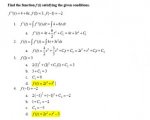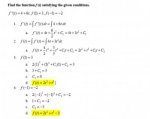Hi all,
This is my first time posting in here, so I'm hoping I can find some help with this one problem that has been giving me trouble. I am currently wrapping up a Calculus I class for college, and have completed all required assignments (even the ones that are due two weeks from now), yet I am completely stuck on this problem. I'm hoping that I am missing something simple here, and that my brain has just decided to lock itself out of a common sense evaluation of what I need to do, but here goes.
It is simpler to just post a screenshot of my work thus far - we have to show all work via MathType as opposed to written out on paper. I am good with taking the integrals of the function, that's not the problem.. the problem is that I end up with two variables of the constant C (C1t and C2) in the final f(t) function and neither of the values they give eliminates either of the C's so I can solve for the other. So this has really become an algebra problem I suppose..
Please disregard my work past Step 3, part a, as this is where I made errors prior.. everything up to that point should be correct.

The examples in the book are far more straightforward and give at least one f(0) condition that allows you to easily solve for one of the C's (as it sets all other terms to zero) but in this case this does not work. I end up with two variables of the Constant C and I am unable to figure out how to solve for them to get the right value for both f(t) and f'(t).
Any help is greatly appreciated!!
Rob
This is my first time posting in here, so I'm hoping I can find some help with this one problem that has been giving me trouble. I am currently wrapping up a Calculus I class for college, and have completed all required assignments (even the ones that are due two weeks from now), yet I am completely stuck on this problem. I'm hoping that I am missing something simple here, and that my brain has just decided to lock itself out of a common sense evaluation of what I need to do, but here goes.
It is simpler to just post a screenshot of my work thus far - we have to show all work via MathType as opposed to written out on paper. I am good with taking the integrals of the function, that's not the problem.. the problem is that I end up with two variables of the constant C (C1t and C2) in the final f(t) function and neither of the values they give eliminates either of the C's so I can solve for the other. So this has really become an algebra problem I suppose..
Please disregard my work past Step 3, part a, as this is where I made errors prior.. everything up to that point should be correct.
The examples in the book are far more straightforward and give at least one f(0) condition that allows you to easily solve for one of the C's (as it sets all other terms to zero) but in this case this does not work. I end up with two variables of the Constant C and I am unable to figure out how to solve for them to get the right value for both f(t) and f'(t).
Any help is greatly appreciated!!
Rob



